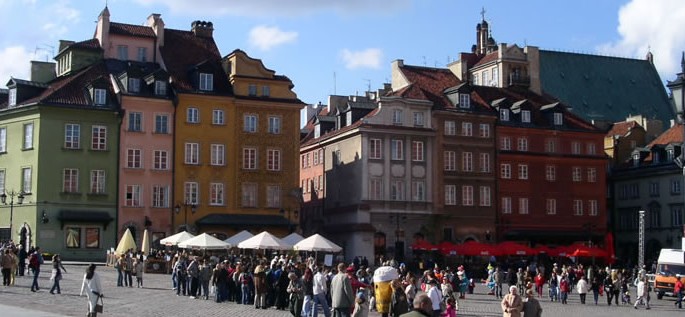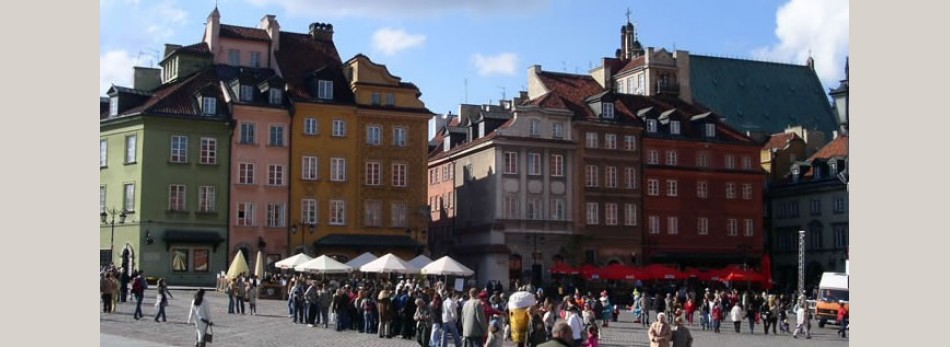Polish

Polish (język polski) belongs to the west Slavic group of the Slavic branch of the Indo-European language family. Its closest living relatives are Czech, Slovak, and Sorbian. It is spoken by 36.6 million people in Poland. It is also spoken in Australia, Austria, Azerbaijan, Belarus, Canada, Czech Republic, Estonia, Finland, Germany, Hungary, Israel, Kazakhstan, Latvia, Lithuania, Romania, Russia, Slovakia, Ukraine, United Arab Emirates, and U.S. The worldwide population of speakers of Polish is estimated at around 39 million (Ethnologue).
Click here to see where Polish is spoken in the U.S.
After the First Partition of Poland in 1772 by Prussia, Austria, and Russia, Poland disappeared from the map. The partitioning countries tried to replace Polish with German or Russian. Polish was restored as the official language of the Polish state after the First World War. Today, Polish is the national language of Poland, one of the most linguistically homogeneous countries of Europe, with over 90% of its population who consider Polish to be their first language. It is used in all official, social, and personal situations.
Dialects
Polish has a number of mutually intelligible dialects. The main ones include:
- Wielkopolski (Greater Polish), spoken in western Poland
- Malopolski (Lesser Polish), spoken in southern and southeastern Poland
- Mazovian (Mazur), spoken in northeastern Poland, including the capital of Warsaw
Structure
Polish has a relatively simple vowel system and a complex consonantal system.
Vowels
There are five oral and two nasal vowels the latter retained from ancestral Proto-Slavic. In script, nasal vowels are marked by a diacritic called ogonek ‘little tail,’ e.g., /ɛ̃/ written as ę , and /ɔ̃/ written as ą.
|
Front
|
Central
|
Back
|
|
|---|---|---|---|
| Close |
i
|
u
|
|
| Open-mid |
ε, ɛ̃
|
ɔ, ɔ̃
|
|
| Open |
a
|
Nasal vowels occur at the end of words or before fricatives. Before stops and affricates, only oral vowel + nasal consonant may occur, e.g., e.g., kąt is pronounced as [kɔnt], gęba is pronounced as [gεmba].
Consonants
- The Polish consonant system is strikingly rich, with an abundance of affricates.
- In addition to typical Slavic oppositions, such as between unpalatalized and palatalized consonants, and voiceless and voiced consonants, Polish has an additional opposition between alveolar and pre-palatal fricatives and affricates, i.e., between /ʃ/ and /ɕ/, /ʒ/ and /ʑ/, /tʃ/ and /tɕ/, /dʒ/ and /dʑ/. The difference is that /ʃ/, /ʒ/, /tʃ/ and /dʒ/ are pronounced with the tip of the tongue, whereas /ɕ/, /ʑ/, /tɕ/, and /dʑ/ are produced with the middle of the tongue.
- Double consonants are quite common, e.g., lekki ‘light’ and leki ‘medicines.’
- Voiced consonants (except nasals, laterals, and rhotics) are devoiced at the end of words, e.g., Bóg ‘God’ is pronounced as [buk].
|
Bilabial
|
Labio-dental
|
Dental
|
Alveolar
|
Alveolo-palatal
|
Velar
|
||
|---|---|---|---|---|---|---|---|
| Stops |
voiceless
|
p, pʲ
|
t
|
k; kʲ
|
|||
|
voiced
|
b, bʲ
|
d
|
g, gʲ
|
||||
| Fricatives |
voiceless
|
f, fʲ
|
s
|
ʃ
|
ɕ
|
x
|
|
|
voiced
|
v, vʲ
|
z
|
ʒ
|
ʑ
|
|||
| Affricates |
voiceless
|
ts
|
tʃ
|
tɕ
|
|||
|
voiced
|
dz.
|
dʒ
|
dʑ
|
||||
| Nasals |
m, mʲ
|
n, nʲ
|
|||||
| Laterals |
l
|
||||||
| Rhotic |
r
|
||||||
| Approximants |
w
|
j
|
- /pʲ, /bʲ/, /kʲ/, /gʲ/, /fʲ/, /vʲ/, /mʲ/, /nʲ/ represent palatalized consonants produced with the blade of the tongue coming in contact with the hard palate.
- /kʲ/ = k in keen
- /gʲ/ = g in geese
- /ʃ/ = sh in shop
- /ɕ/ = sh in sheet
- /ʒ/ = s in treasure
- /ʑ/ has no equivalent in English
- /tʃ/ = ch in chop
- /tɕ/ = t in nature
- /dʒ/ = j in job
- /dʑ/ = j in juice
- /x/ = German pronunciation of ch in Bach
Stress
Stress in Polish words falls mostly on the penultimate (next to the last) syllable in a word.
Polish is a richly inflected language with a grammar that is similar to that of other Slavic languages.
Nouns, adjectives, and pronouns
Polish nouns and adjectives are marked for gender, number, and case. The three are fused into one ending, as is the case in all Slavic languages. Polish nouns have the following grammatical categories:
- There are three genders: masculine, feminine, neuter.
- The our noun and adjective declensions are largely based on gender.
- There are two numbers: singular and plural.
- There are seven cases: nominative, genitive, dative, accusative, instrumental, locative, and vocative. Only a few nouns have retained the vocative forms.
- Animate and inanimate masculine nouns have different endings in the accusative case, with the animate nouns marked with the same endings as in the genitive case.
- There are no indefinite or definite articles.
- All modifiers agree with the nouns they modify in gender, number, and case.
- An interesting feature of the Polish pronominal system is that the formal second-person pronouns are the same as the nouns pan ‘Mr.’, pani ‘Mrs.’ , and their plural forms ‘panowie, panie‘. The formal 2nd person form of address is used with 2nd person verb forms.
Verbs
Polish verbs agree with their subjects in person and number in the non-past, and in gender and number in the past. They are marked for the following categories:
-
- Verbs are marked for person and number. There are three persons (first, second, third), and two numbers (singular and plural). Like all Slavic languages, Polish is a pro-drop language, i.e., personal pronouns can be dropped because the verb ending makes the person clear.
- Verbs are marked for aspect: imperfective and perfective. Most verbs consist of imperfective-perfective pairs. Perfective verbs can be formed from imperfective verbs by prefixation, e. g., jeść ‘to eat’ and zjeść ‘to eat up, to finish eating’. It is also possible to derive imperfective verbs from perfective ones by suffixation.
- Imperfective verbs have three tenses: present, past, and future, The future tense is a compound form using the verb być ‘to be’.
- Perfective verbs have two tenses: past and future. The future tense is a simple form that uses the same endings as the present tense.
- Verbs in the present/past tense have six conjugations based on the form of the stem. There are many irregular forms.
- There are three moods: indicative, imperative, conditional.
- Verbs have two voices: active, passive.
- Verbs of motion constitute a special subcategory of verbs. They are characterized by a complex system of directional and aspectual prefixes and suffixes.
Word order
The neutral word order in Polish is Subject-Verb-Object. However, other orders are possible since inflectional endings take care of clearly marking grammatical relations and roles in the sentence. Word order is principally determined by topic (what the sentence is about, or old information) and focus (new information). Constituents with old information precede constituents with new information, or those that carry the most emphasis.
Most of Polish vocabulary is derived from Common Slavic roots that are shared by all Slavic languages. In addition, Polish has been influenced over the centuries by a number of languages, especially Old Church Slavonic, Latin, Greek, German, French, Ukrainian, Belarusian, and Russian.
Most of Polish vocabulary is derived from Common Slavic roots shared by all Slavic languages. In addition, Polish has been influenced over the centuries by a number of languages, including Old Church Slavonic, Latin, Greek, German, French, Ukrainian, Belarusian, and Russian.The spelling of loanwords was usually changed to accommodate Polish pronunciation, and various suffixes were added to create nouns, adjectives, and verbs. When borrowing international words, Polish often changed their form. For example, the Latinate suffix -tion becomes –cja in Polish, e.g.,inauguration becomes inauguracja.
Here are a few common phrases and words in Polish.
| Hello, good day | Cześć, dzień dobry |
| Good bye | Do widzenia |
| Please | Proszę |
| Thank you | Dziękuję |
| Excuse me | Przepraszam |
| Yes | Tak |
| No | Nie |
| Man | Mężczyzna |
| Woman | Kobieta |
Below are the Polish numerals 1-10.
|
1
|
2
|
3
|
4
|
5
|
6
|
7
|
8
|
9
|
10
|
|---|---|---|---|---|---|---|---|---|---|
|
jeden
|
dwa
|
trzy
|
cztery
|
pięć
|
sześć
|
siedem
|
osiem
|
dziewięć
|
dziesięć
|
Writing
Polish is first attested in 9th century documents written in medieval Latin. Whole Polish texts started to appear in the 16th century, including the first printed book in Polish in 1513. The 16th century also saw the appearance of the first Polish dictionaries and grammars. Since Poland was predominantly Roman Catholic, it was natural for the Polish alphabet to be was based on the Latin, rather than on the Cyrillic alphabet. The language uses an adapted and expanded version of the Latin alphabet. Because Polish has many sounds that were absent in Latin, many diacritics and combinations of letters were designed to represent them. The result is an alphabet replete with diacritics.
Below are the letters of the modern Polish alphabet.
|
A a
|
Ą ą
|
B b
|
C c
|
Ć ć
|
D d
|
E e
|
Ę ę
|
F f
|
G g
|
H h
|
|
I i
|
J j
|
K k
|
L l
|
Ł ł
|
M m
|
N n
|
Ń ń
|
O o
|
Ó ó
|
P p
|
|
R r
|
S s
|
Ś ś
|
T t
|
U u
|
W w
|
Y y
|
Z z
|
Ź ź
|
Ż ż
|
.
|
- irepresents /i/ and palatalizes the preceding consonant
- y represents /ɨ/ or nasalize /ɘ̟/.
- c represents /ts/.
- ć represents /tɕ/.
- cz represents /tʃ/.
- ł represents /w/.
- ż represents /ʒ/.
- ś represents /ɕ/.
- sz represents /ʃ/.
- ó and u represent /u/.
- w represents /v/ or /v’/.
- ź represents /ʑ/.
- ń represents /n’/.
Take a look at article 1 of the Universal Declaration of Human Rights in Polish.
|
Artykuł 1 Wszyscy ludzie rodzą się wolni i równi pod względem swej godnośći i swych praw. Są oni obdarzeni rozumem i sumieniem i powinni postępować wobec innych w duchu |
Here are a few words English has borrowed from Polish:
|
kielbasa
|
from Polish kielbasa ‘sausage’ (Russian kolbasa), perhaps from Turkish kulbasti ‘grilled cutlet’ |
|
mazurka
|
from Russian mazurka, from Polish mazurek ‘dance of the Mazur,’ a reference to inhabitants of Mazowsze , a region of central Poland. |
|
sejm
|
Congress of the Polish Republic, from Polish sejm ‘assembly’ |
| solidarność | ‘Solidarity,’ name of Polish trade union federation founded in September 1980 at the Gdansk shipyards, and originally led by Lech Walęsa. In the 1980s, it constituted a broad anti-communist social movement that advocated nonviolence. |







